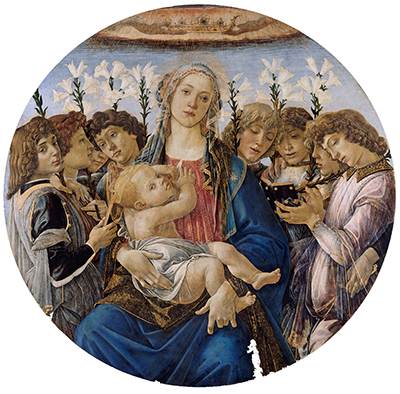This round fresco (tondo) from 1478 is now owned by the Staatliche Museum in Berlin
There are relatively few tondos in Botticelli's career, making this fresco particularly rare and intriguing. It was completed in his standard method of tempura on panel.
This painting has been termed as the Raczynski Tondo because of the previous owners of it before being purchased in the late 19th century by the Berlin Gemäldegalerie.
It is likely to have been on display originally at the San Salvatore al Monte although this has never been entirely proven. It is the views of famous Renaissance biographer, Vasari, which have provided evidence for this solid theory.
The most famous tondo, or round painting, would have to be Doni Tondo by Michelangelo which is currently displayed on the 2nd floor of the Uffizi Gallery, which is a section of this world famous art museum which is devoted entirely to the work of Michelangelo.
The composition of Madonna with Lillies and Eight Angels is noticeably symmetrical and also offers the artist an opportunity to display his supreme portraiture skills. He had used drawings and other previous frescos to perfect his anatomical depictions, sometimes even amended paintings directly on the panel in order to adjust poses and positions.
Mary breastfeeds her child in this scene, whilst being accompanied by eight angels. Botticelli's decision to point the Madonna's eyes directly at the viewer enables him to create a strong bond between the painting and those perusing it. You may notice the lilies which represent purity, in this case referring specifically to Mary.




